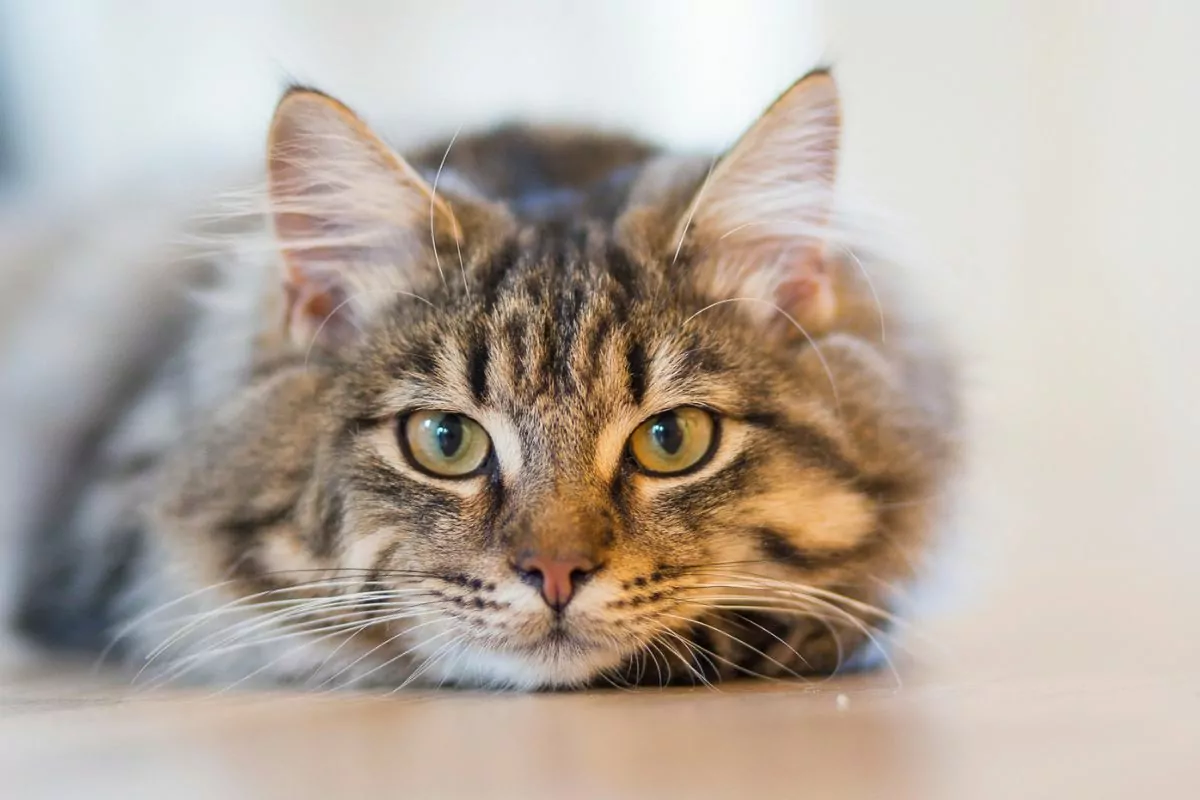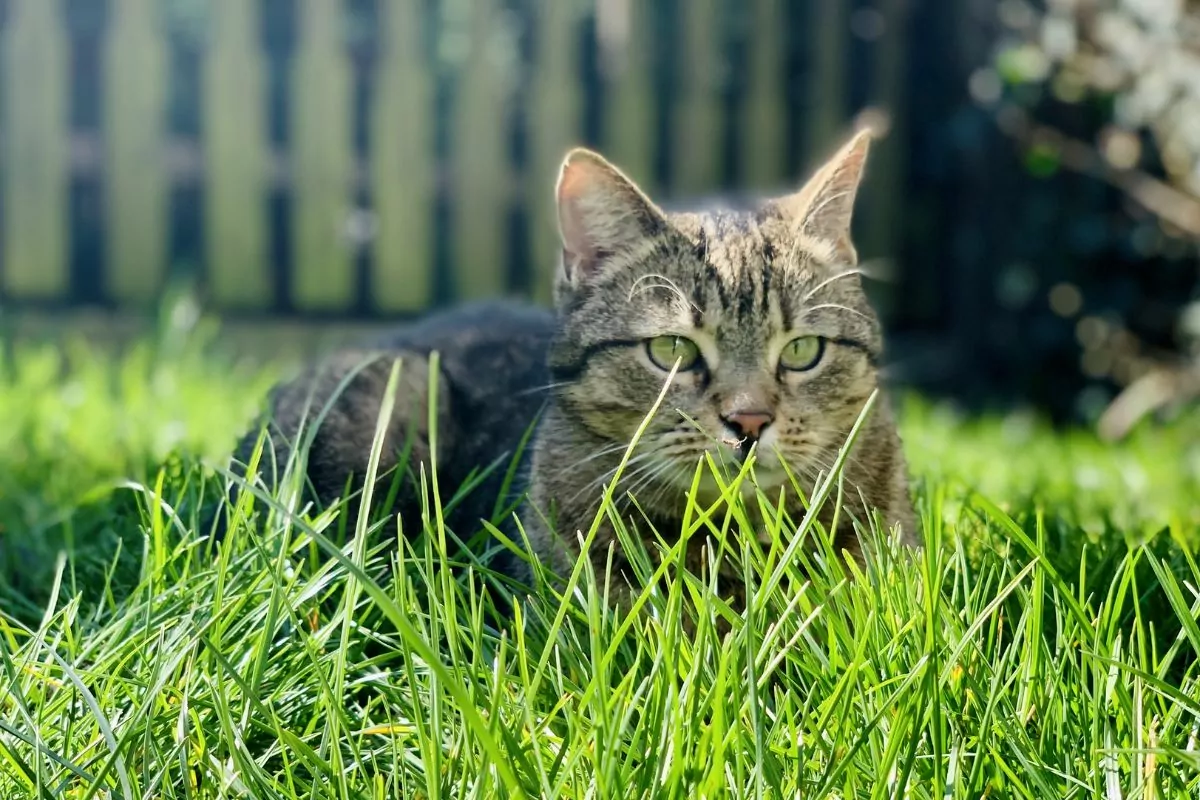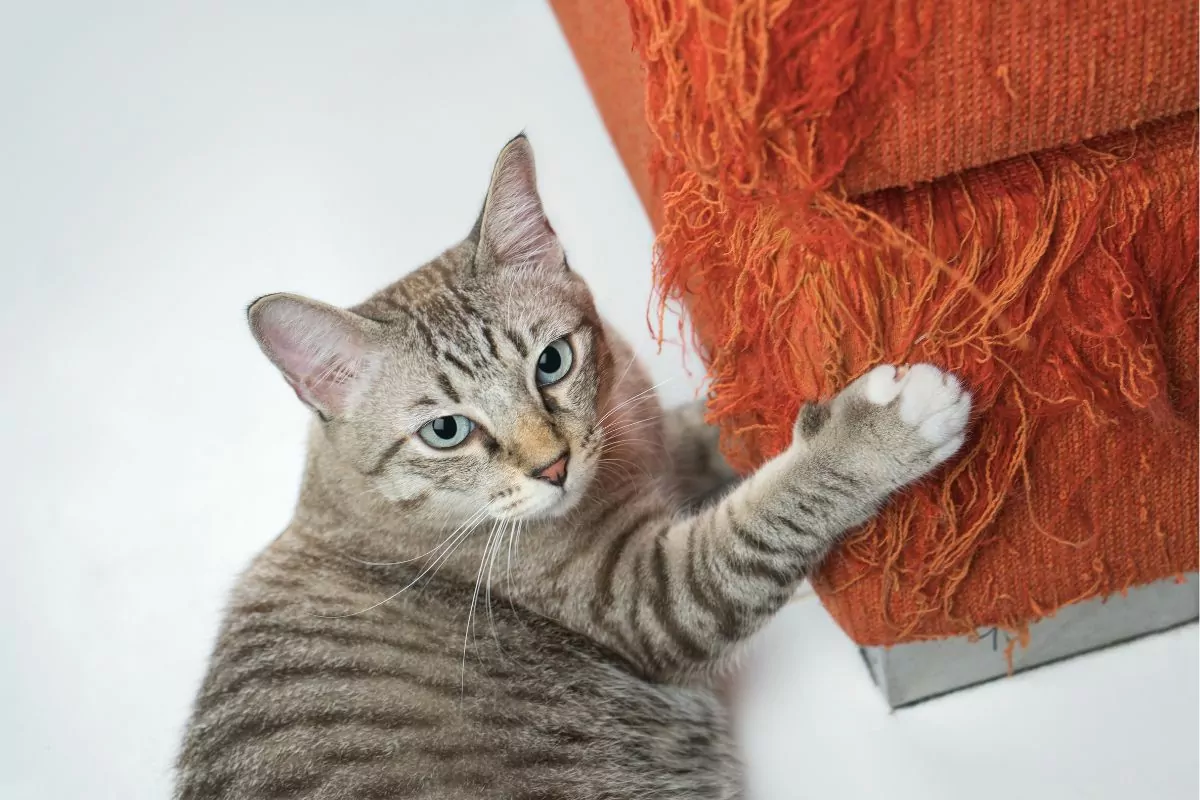Cystitis in cats affects the urinary tract and can cause severe discomfort. Difficulty urinating can be painful and even fatal if not detected in time. Here, we will guide you so that you can identify the symptoms in time and take your furry cat to the veterinarian immediately.
What is Cystitis in Cats?
Cat cystitis means inflammation of the bladder. It is a non-specific term used to encompass all pathologies that present similar clinical symptoms of the lower urinary tract. Although these pathologies share the same clinical signs, the causes that originate them are very varied.
Feline idiopathic cystitis (FIC) is the most common type in cats under 10 years, characterized by a sterile bladder inflammation without a known cause.

The Different Types of Cystitis in Cats
- Urolithiasis is the most frequent cause of cystitis in cats older than 10. It consists of the presence of crystals and urinary calculi in the bladder. The presence of crystals in the urethra of the male cat leads to its obstruction. The most common crystals are calcium oxalate and struvite. Diagnosis is through urinalysis and imaging (radiographs – ultrasound).
- Bacterial infection of the urinary tract. Rare in cats. They are ascending infections, which come from the colon or the skin of the perianal region and reach the bladder through the urethra. Escherichia (E.) coli is the primary bacterium involved in this pathology. Female cats are more prone to infection because the urethral outlet is close to the anus. Diagnosis is by urinalysis (including sediment analysis and bacterial culture).
- Bladder wall neoplasia. Primary tumors of the urinary tract are rare. Urinalysis and imaging (radiographs – ultrasound) are necessary for diagnosis.
- Neurological disorders. Bladder dysfunctions (flaccid or spastic) caused by neurological damage (e.g., trauma). Diagnosis is by cystoscopy or urodynamic tests.
- Anatomical abnormalities. Cats may be born with abnormal lower urinary tract anatomy or develop abnormalities due to trauma.
- Idiopathic cystitis in cats (FIC). Sterile cystitis in cats (because it occurs in the absence of bacteria) or interstitial cystitis in cats (the pathology lies within the interstitium of the bladder wall.). It is necessary to rule out all the causes mentioned in the previous points, and when such investigations do not reveal a specific underlying cause, FIC is the presumptive diagnosis.
Cystitis in Cats (Symptoms)
All types of cystitis present similar symptoms. So, we will mention below the clinical signs of cystitis in cats without distinguishing the cause that gave rise to it.
Cystitis in cats symptoms can be obstructive (when there is no urine outflow from the urethra) and non-obstructive (when the urethral lumen decreases, but the cat can still urinate).
The clinical signs of non-obstructive cystitis are:
- Dysuria: Difficulty urinating. Cats with cystitis often go to the litter box, spend a lot of time straining to urinate, and make painful sounds but only expel droplets of urine.
- Polakyuria: Increased urinary frequency. Unable to empty the bladder, affected cats have a constant urge to urinate and make frequent trips to the litter box.
- Hematuria: Blood in the urine. Blood mixed with urine or blood clots may be present.
- Cloudy concentrated urine
- Urinating in unusual places, outside of the litter box
- Excessive toileting or licking in the genital region
- Lack of energy
- Decreased appetite
- Vomiting or diarrhea
- Behavioral changes
In obstructive conditions, the patient goes to the litter tray but cannot urinate. It is a veterinary emergency because the urine accumulates in the bladder and runs the risk of rupturing. In turn, the body cannot expel the toxins through the urine, and they intoxicate the cat, causing a neurological condition. (incoordination, dizziness, anorexia, depression, seizures).
What Causes Cystitis in Cats?
Feline idiopathic cystitis is the most common type of cystitis in cats. Yet, understanding how FIC develops is challenging, unlike the other types of cystitis.
The term “idiopathic” refers to its origin being unknown. Stress is the most crucial trigger for this cystitis, but not the cause. Stressors to a cat may include:
- Conflicts with other cats inside or outside the home,
- Changes in diet,
- Owner stress,
- Moving house,
- Addition of new animals or people to the household
Other risk factors for the presentation of FIC are:
- Sedentary nature and inactivity
- Obesity
- Age (up to 10 years with an average of four to seven years).
- Sex: Males are more prone to suffer from FIC.
As for the cause, although it is not yet clear, cats predisposed to FIC, unlike normal cats, have a lower tolerance to stress. It means that what may go unnoticed by a normal cat can be very stressful for a cat prone to FIC.
FIC affects cats that have a failure in the physiological stress response. So, when a susceptible cat suffers a stressful situation, the hormones released into the bloodstream reach the bladder wall, affecting its permeability. So:
- Inflammatory mechanisms appear.
- Substances from urine become absorbed, affecting the cat’s nervous system and causing pain.
In summary, after a stressful situation, a cat prone to FIC has a very inflamed bladder wall (and urethra) and a lot of pain.
After explaining all these mechanisms, it is clear that FIC is an aseptic process, i.e., no bacteria are present.
Do Male and Female Cats Get Cystitis?
Both male and female cats can suffer from cystitis. However, cystitis in male cats is more common due to their narrow urethra.
CIF in females is not usual because of their wider urethral lumen. But, unlike the male, its proximity to the anus makes it more susceptible to bacterial cystitis.

Treatment for Feline Cystitis
Cat cystitis treatment depends on the cause of the disease.
- Urolithiasis: In non-obstructive processes, struvite crystals and stones have the particularity of dissolving by administering a specialized diet (meals containing low amounts of protein, reduced amounts of phosphorus and magnesium, besides a urine acidifier to achieve urinary pH modification). Calcium oxalate stones do not dissolve with diet and need surgical treatment for their removal.
In males, if crystals obstruct the urethra, the procedure is an emergency.
- Bacterial infection of the urinary tract: After performing the culture and obtaining a positive result for bacteria, selecting the appropriate antimicrobial against the isolated agent is important.
- Neoplasia of the bladder wall: Each case needs an individual evaluation to decide the best surgical or chemotherapeutic treatment that suits the animal’s situation.
- Neurological disorders: Depending on the trauma, the neurogenic bladder may be flaccid or spastic. Both situations cause urinary incontinence. The veterinarian evaluates each case and its prognosis. Palliative treatment may include medication and urethral catheterization.
- Anatomical abnormalities: Surgical treatment
- Managing idiopathic cystitis in cats:
It is essential to mention that acute cases of stress cystitis in cats resolve themselves in five to eight days without the cat needing medication. Yet, if no intervention occurs, these days will be excruciating for the feline. And the problem is likely to become chronic and recurrent, too.
Since the cause of CIF is unknown, no specific treatment exists to solve it. The most important aspect is to relieve the cat’s discomfort. For pain, use non-steroidal anti-inflammatory drugs, like Meloxicam and buprenorphine, as an analgesic. Add a muscle relaxant; we obtained good results with Prazosin in cats.
Treatment with polysulfated glycosaminoglycan injections (GAG) is an excellent option. It is a drug often used in chronic joint problems to help prevent the degradation of joint cartilage. But, it turns out that this substance also lines the bladder. In cats with CIF, the GAG layer of the bladder wall deteriorates, and injections can help replace it. Glycosaminoglycans bind to the damaged bladder uroepithelium, and cats recover faster from an episode of CIF.
L-tryptophan is an essential amino acid and precursor of serotonin. This amino acid regulates many behavioral processes, such as aggressive behavior and stress response. Supplementation with L-tryptophan is an option for cats with low stress tolerance.
In severe cases, when the cat, despite all efforts, does not lose fear and stress, the veterinarian may prescribe tricyclic antidepressants, such as Amitriptyline. Use this drug on a prolonged basis; otherwise, it increases the chances of recurrence. Its side effects are weight gain, excessive vocalizations, and decreased cat grooming.
The use of pheromones in spray form, together with medical and environmental treatment, improves the results.
The Chances of Recurrency
Recurrent episodes of CIF are often described and affect most cats predisposed to this pathology.
The secret to reducing the possibility of recurrent cystitis in cats is to do our best to reduce potential sources of stress. In controlled environments (as shown below), cats predisposed to CIF will not manifest new clinical signs or behavioral alterations.
Is Cat Cystitis an Emergency?
Obstructive cystitis in male cats is an emergency because the cat cannot urinate. Here lies the importance for owners to recognize the symptoms and immediately notify the veterinarian.
First, the specialist will perform blood tests and complementary studies. Intravenous fluid therapy and pain medications are necessary. Then, the vet will proceed to the obstruction under sedation. Using a ureteral catheter up to the bladder allows the evacuation of all bladder contents. The animal must remain hospitalized to observe its evolution, and the ureteral catheter stays in for three days to avoid recurrences.
How to Prevent Cat Cystitis
Because:
- Of the complexity of this pathology,
- Idiopathic stress-induced cystitis is the most common type of cystitis,
- It has no specific medical treatment and
- Stress plays a significant role in its development.
Preventive Treatment is Paramount
The therapeutic plan for FIC can vary from cat to cat. It should consider identifying possible sources of stress for each patient and implementing individual measures, depending on the cat, to reduce or eliminate these causes.
The stress suffered by or affecting an animal predisposed to FIC is a continuous and cumulative process. Thus, the goal is to change the animal’s environment. To achieve a controlled and enriched environment so that the predisposed cat, on an individual level, remains below its threshold of stress reaction and does not become ill. The multimodal environmental modification approach (MEMO) is practical for this.
To install the modification of the environment, we must first know what would be the ideal state for a cat. These animals are solitary, territorial, and not very hierarchical. They do not form herds like dogs but live in areas with reliable resources and maintain stable populations.
Multimodal environmental modification takes into account five critical environmental aspects:
Diet and Water Consumption
Cats eat several times a day in small quantities, so food must always be available, except for overweight cats. In this case, interactive feeders are an excellent option because they prevent the cat from eating out of boredom, do physical exercise, and stimulate them because food becomes difficult to get.
When there are many cats in the house, the feeders should be individual and separated from each other by at least one meter.
About the type of food, several brands of medicated food dissolve uroliths in cases of cystitis due to urolithiasis. In cases of FIC, increase the amount of wet food administered. Increasing water intake in cases of cystitis is essential to maintain good renal function and avoid the recurrence of the disease.
Cats like fresh, running water that is somewhat away from the food. Placing more than one drinking fountain in different locations helps reduce stress, especially when many cats are in the same house. Fountains designed for pets are another excellent resource.
Both water and food should be away from the litter pan, in separate rooms.
Optimal Litter Tray Care
The litter pan is a key point in modifying the environment. Many cats with FIC have a problem with their litter tray. There are several factors to consider:
It should be in an accessible and quiet place in the house, away from loud noises, and well-ventilated. In multi-story houses, there should be at least one tray per floor.
As for the type of litter, cats prefer fine-textured clumping litter because it does not get stuck between their toes. The sand in the tray should be five centimeters deep or more.
Litter trays should be large, at least 1.5 times the cat’s size, measured from the nose’s tip to the tail’s base. The cat should fit entirely inside the tray, with the ability to turn around and scratch the litter by extending its paws. Most commercial trays do not meet these requirements. An excellent idea is to use large plastic storage boxes, such as those stored under beds, instead; they usually have a large surface area, and the edges are not too high so the cat can get into them. Whereas, if owners choose a storage box with high edges, it is advisable to cut one side to leave it open and allow the cat easy access. Replace sand trays every year, as plastic is a porous material.
For most cats, the litter pan’s location, cleanliness, and substrate seem more important than whether it has a cover. Even so, we recommend uncovered trays, as owners seem to pay more attention to the trays when the dirt is visible or the odor is more noticeable.
As for the number of trays in the house, if there is only one cat, one tray is enough. Even one tray may be enough if two cats are in the house and have a good relationship. Not so in the case that these two individuals have a bad coexistence. In this case, have at least two litter boxes. If there are more than two cats in the household, the recommendation is that the number of trays should be equal to the number of cats in the house plus one.
The key elements are cleaning the sand tray and removing debris at least once a day. One factor that owners neglect is the thorough cleaning of the cat’s litter tray, which we recommend doing at least once a month with clumping litter or more often if the litter is not clumping. It involves throwing out the litter, cleaning the tray with hot, soapy water, and, once dry, refilling it with new litter.
Resting and Grooming
Cats like elevated resting places. This resting area should be separate from the litter tray and food area. Cats use resting areas for grooming, so their grooming may decrease if these areas are inappropriate.
It is also necessary to provide them with materials to sharpen their nails. These can range from commercial scratching posts to tree trunks. The chosen material should not move while the cat is using it. Otherwise, it will look for another place that meets its expectations, such as a sofa in the living room.
Three-dimensional space is important for cats. Thus, we should not limit ourselves to only one horizontal or vertical scratching post. Rather, use different scratchers in both positions to avoid stressing the cat.
Routine
Small changes in a cat’s routine can cause major alterations in the cat’s life, leading to a significant increase in stress. A cat’s life prone to FIC should be very routine, respecting feeding schedules, static places for the litter box, several options for hiding areas, etc. Introducing new animals into homes where a cat with idiopathic cystitis lives is not advisable as their stress level is likely to increase.
If changes must happen, the more gradual, the better. For example, if a change in feeding becomes necessary, it is advisable to continue to offer the usual food in the same food bowl and introduce the new food in the same place. Little by little, owners can reduce the amount of the old food and increase the amount of the new food.
Play
Cats need and should play throughout their lives. There are many toys, commercial and homemade, that entertain cats. It is important that the cat does not have constant access to all its toys but that they remain in storage, and we only take out two or three at a time and alternate them with others every few days. In this way, the toys remain novel for the cat. Toys containing catnip are often eye-catching, as is grass alone if we rub it on toys or its scratching post.

Parting Thoughts
After reading this article, we understand cystitis is a complex pathology that can even result in a medical emergency. This condition is frequent among domestic cats due to the human lifestyle and proximity to their pets. Owners must be alert to the symptoms and, more than anything, try to prevent their appearance.
